The Singapore Flag’s Performance in 2016
In 2016, Singapore ships performed significantly better under Port State Control (PSC) in both the Tokyo and Paris MoU regimes:
- Tokyo MoU regime – the detention ratio of Singapore ships is 0.78% against the regime’s average of 3.45%.
- Paris MoU regime – the detention ratio of Singapore ships is 1.49% against the regime’s average of 3.79%.
The SRS performance under the Tokyo and Paris MoU regimes over the past five years are illustrated in Figures 1 and 2 below.
Tokyo MoU - Annual Detention Ratio
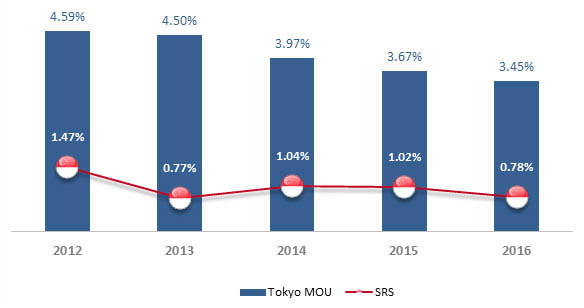
Figure 1
Paris MoU - Annual Detention Ratio

Figure 2
A total of 41 Singapore ships were detained under PSC worldwide, of which 43% took place in Australia (13 detentions) and the United States (5 detentions).
The breakdown of Singapore ship detentions by Port States is given below.
PSC Detention of Singapore Ships by Port State, 2016
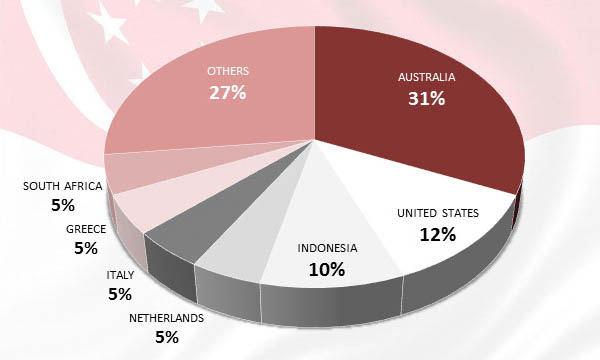
Figure 3
Most Common Causes of Ship Detentions
From the analysis of detention statistics in 2016, the four most common categories of PSC detention deficiencies are fire safety, pollution prevention, life-saving appliances and ISM. These categories make up almost 63% of the total detention deficiencies. The PSC detention deficiencies under these four categories are summarised as follows:
Fire Safety
- Ship’s crews not able to carry out satisfactory fire drills
- Use of non-approved pumping arrangements to transfer leaked cargo oil in pump-room to slop tank
- Defective fire detection and alarm system
- Defective quick closing valve of emergency generator fuel oil tank
- Defective funnel damper
Pollution Prevention
- Defective oil discharge monitoring and control system
- Sewage treatment plant out of order and/or not in use
- Erroneous entries in oil record book
Life Saving Appliances
- Defective starting arrangements of lifeboat and rescue boat engines
- Defective lifeboat and rescue boat launching arrangements
- Lifeboat structural damage
ISM
- Serious failure in ISM implementation: shipboard operations and maintenance, and emergency preparedness
The breakdown of all the PSC detention deficiencies found on Singapore ships in 2016 are given below.
Detention Deficiencies by Category, 2016
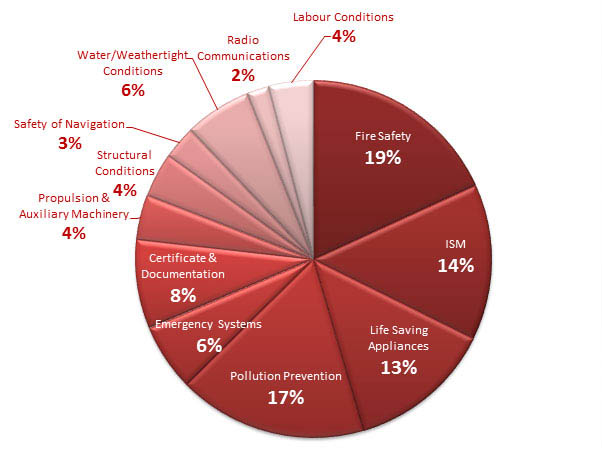
Figure 4
Top 10 Detention Deficiencies, 2016
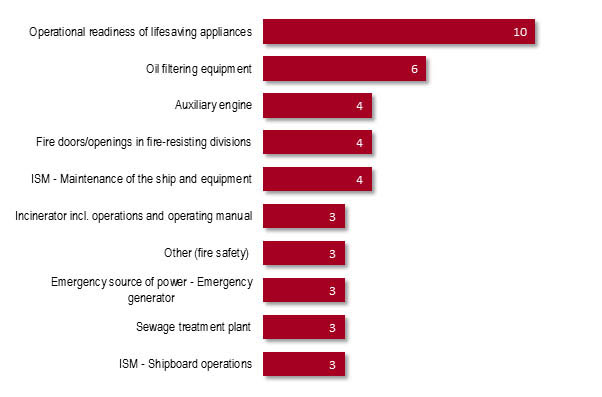
Figure 5
Case Study on Ship’s Oily Water Separator
US$40 million! That is not the prize for the 2017 Singapore Pool Hong Bao draw but the hefty penalty that the Princess Cruise Lines have to pay after pleading guilty to charges of MARPOL violation involving the use of “magic pipe” on one of their ship to bypass the oily water separator (OWS) and discharge about 16 cubic metres of untreated engine room bilge water off the English coast in 2013. Similar illegal practices, including the manipulation of the OWS oil content monitor, were also found on four other ships of the company.
The OWS is regularly inspected during port State control (PSC) inspections. In 2016 alone, eight (8) Singapore ships were detained under PSC due to the following OWS-related deficiencies:
- OWS inoperable. Oil record book entries not in order.
- 15ppm oil content meter defective - displaying error or unable to be reset after alarm condition. Sampling line disconnected or crimped.
- Automatic stopping device (changeover valve) not activated when oil content exceeded 15ppm.
- Overboard outlet pipe before the shipside valve is filled with oil.
- OWS casing corroded and holed.
- Bilge separator pump defective. Pump gland leaking seriously.
- Crew not familiar with the operation of the OWS and 15ppm oil content meter, or unable to retrieve data from the recording device.
- Crew not able to demonstrate the operation of the OWS and 15 ppm bilge alarm.
It is therefore important that companies pay close attention to how oily water and wastes are being treated onboard their ships. They should implement effective measures to ensure:
- Compliance with MARPOL requirements on their ships at all time;
- That their crew are properly familiarised in the operation and maintenance of the pollution prevention equipment, as well as proper maintenance of Oil Record Book entries;
- Clear procedures and instructions, giving due regard to the manufacturer’s recommendations, are established to guide their crew in operating and maintaining pollution prevention equipment effectively;
- Routine inspection, testing and maintenance are effectively and consistently carried out on their ships;
- No unauthorised modification of approved equipment or system on their ships; and
- Control of the use of cleansing agents, emulsifiers, solvents or surfactants on their ships so that they do not affect the performance of the OWS.
Requirements of Revised Annex I of MARPOL 73/78
Under regulation 14 of Revised Annex I of MARPOL 73/78, ships of 400 gross tonnage and over have to be fitted with approved type1 of OWS to ensure any oily mixture discharged into the sea after passing through the system has an oil content not exceeding 15 ppm. On ships of 10,000 gross tonnes and above, the OWS shall be provided with 15 ppm bilge alarm (oil content meter) and automatic stopping device (changeover valve) to automatically stop any discharge overboard when the oil content of the effluent exceeds 15 ppm.
OWS installed on or after 1 January 2005 has to comply with more stringent requirements:
- Response time of the 15 ppm bilge alarm should not exceed 5 seconds;
- 15 ppm bilge alarm should record date, time and alarm status, and operating status of the OWS;
- Recording device should store data for at least 18 months and be able to display or print a protocol for official inspections as required; and
- To avoid wilful manipulation, every access of the 15 ppm bilge alarm should require the breaking of a seal.
It is not required to calibrate the 15 ppm bilge alarm on ships. But it is recommended that simple means be provided onboard ships for checking and testing the 15 ppm bilge alarm in accordance with the manufacturer’s instructions. The accuracy of the 15ppm bilge alarm should be checked at IOPP Certificate renewal surveys according to the manufacturer’s instructions, by the manufacturer or authorised persons. The calibration certificate and certifying date of last calibration check should be retained onboard for inspection purposes.
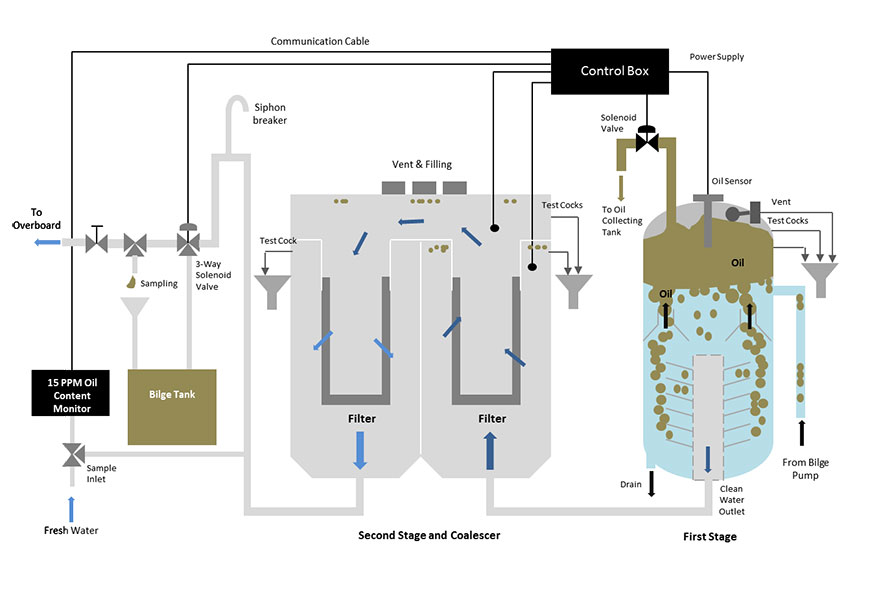
A typical 2-stage OWS comprising separator and coalesce filter chambers
Case Study
OWS are designed to function automatically and require minimum attention to bring it into operation. But in reality, it requires a lot more care and attention, as illustrated by this case study of a PSC detention.
An offshore supply vessel was subjected to an expanded PSC inspection in port. During the inspection, the crew was asked to demonstrate the operation of the OWS and 15 ppm bilge alarm. The equipment was of reputable make and type-approved to the latest standards. But it has not been used regularly.
The Chief Engineer could not readily demonstrate the operation of the 15 ppm bilge alarm. So the PSC inspector went away to inspect other parts of the vessel. After many attempts, the Chief Engineer managed to activate the 15 ppm alarm. But he could not restore it to normal when the PSC inspector returned. The oil content meter was flushed with freshwater, and cleaned with brush and soap, but that did not reset the alarm. The PSC inspector concluded that the OWS was defective and detained the vessel.
The measuring cell of the oil content meter was later taken apart for thorough cleaning. The sampling tube was found discoloured by a coat of iron oxide. This has affected the reading of the 15 ppm oil content meter.
The vessel has been provided with clear operating and maintenance manuals for the OWS. However the crew have not been following the instructions.
According to the manufacturer’s instructions:
- At weekly intervals, flush the measuring cell with clean water and clean the sampling tube with brush. If fouled by iron oxide or calceous deposits, soaking in mild acidic cleaner, citric acid or vinegar is necessary before thorough cleaning with brush and soap. Check the dessicator and dew point of the measuring cell and replenish as required. Humidity can cause condensation and wrong measurement.
- Every month, run the OWS with seawater for about two hours.
- Every two year, change the emulsion breaker, polishing cartridges and the coalescing insert if necessary.
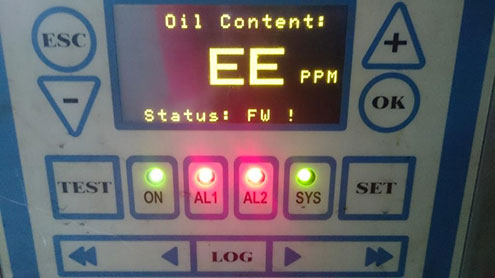
15 ppm oil content meter with error reading
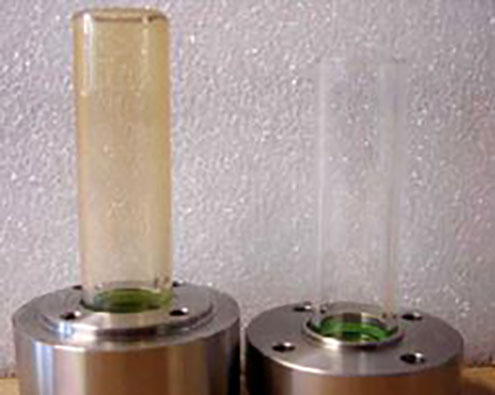
Sampling tube (on the left) discoloured by iron oxide which can affect the function of the oil content meter
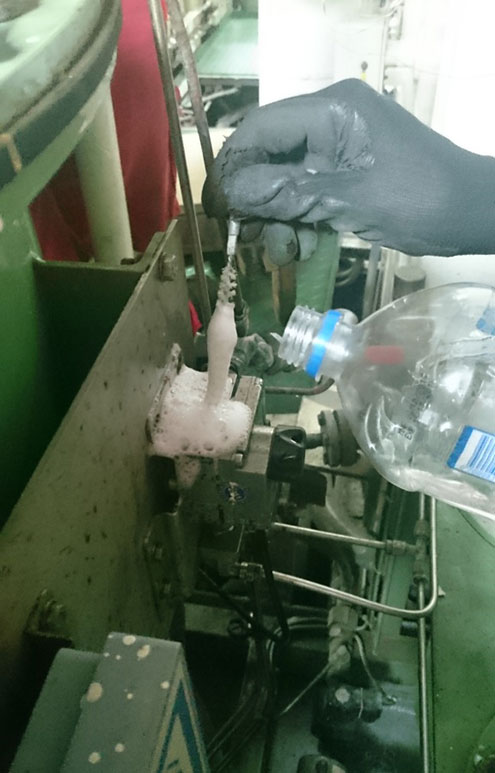
Cleaning the measuring cell with soap and brush may not be enough if it is fouled by iron oxide or calceous deposits
Underlying Causes of Deficiencies
- Routine maintenance of the OWS was not carried according to the manufacturer’s recommendations.
- The manufacturer’s recommendations were not incorporated into the vessel’s planned maintenance system for the OWS.
- The engine crew were not familiar with the operation and maintenance of the OWS and oil content meter.
- Lack of planning, supervision and oversight by senior ship’s officers and the company
Simple and Actionable Corrective Actions
Getting the job done right the first time and every time!
- Review and improve the planned maintenance system for the OWS, giving due regard to the manufacturer’s recommendations.
- Establish clear and adequate procedure, work instructions and checklists to control the operation, inspection, testing and maintenance of the OWS.
- Review and improve the crew familiarisation programme for the crew, and recognise that the OWS is a critical shipboard equipment which is regularly inspected by the flag and port States.
- Review the job description of senior ship’s officers and ensure they adhere to the company’s safety and environmental policy, and maintain proper supervision and oversight of work onboard their ships.
1 The “Revised Guidelines and Specifications for Pollution Prevention Equipment for Machinery Space Bilges of Ships” in resolution MEPC.107(49) apply to equipment installed on board ships on/after 1 January 2005. Resolution MEPC.60(33) applies to equipment installed on/after 30 April 1994 but before 1 January 2005. Resolution A.393(X) applies to equipment installed before 30 April 1994.
Reference:
- Annex I of MAROL Convention:
- Regulation 6.4.3 – Reporting defects of pollution prevention equipment
- Regulation 14 – Oil filtering equipment
- Regulation 15 – Control of operational discharge of oil
- Resolution MEPC.107(49) - Revised Guidelines and Specifications for Pollution Prevention Equipment for Machinery Space Bilges of Ships
- ISM Code,
- Section 6 – Resources and personnel
- Section 7 – Development of plans for shipboard operations
- Section 10 – Maintenance of the ship and equipment
